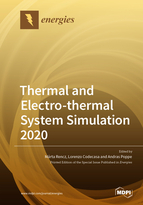Thermal and Electro-thermal System Simulation 2020
A special issue of Energies (ISSN 1996-1073). This special issue belongs to the section "J: Thermal Management".
Deadline for manuscript submissions: closed (15 July 2020) | Viewed by 48701
Special Issue Editors
Interests: thermal investigation of ICs and MEMS; thermal sensors; thermal testing; thermal simulation; thermal model generation; electro-thermal simulation; CPS systems
Special Issues, Collections and Topics in MDPI journals
Interests: electric engineering; electro-thermal circuit modeling and simulation; electromagnetic simulation
Special Issues, Collections and Topics in MDPI journals
Interests: LED testing; thermal simulation; electro-thermal simulation; logi-thermal simulation; multi-domain modeling
Special Issues, Collections and Topics in MDPI journals
Special Issue Information
Dear Colleagues,
As a follow-up to the 25th THERMINIC Workshop, held in Lecco in September 2019, a Special Issue of energies about thermal and multi-physical investigations electronics systems will be edited by Prof. Marta Rencz, Prof. Lorenzo Codecasa and Prof. Andras Poppe.
This Special Issue will target the presentation of the newest research results of thermal effects in electronics today, from characterization to through multi-physics simulation to cooling solutions and reliability assessment.
This special issue is not only collecting papers from the 25th THERMINIC Workshop, but also will containing papers from other scholars who interested in this topic. Papers that were presented at THERMINIC must be revised and contain at least 60% new material that has never been presented before.
Prof. Márta Rencz
Prof. Lorenzo Codecasa
Prof. Andras Poppe
Guest Editors
Manuscript Submission Information
Manuscripts should be submitted online at www.mdpi.com by registering and logging in to this website. Once you are registered, click here to go to the submission form. Manuscripts can be submitted until the deadline. All submissions that pass pre-check are peer-reviewed. Accepted papers will be published continuously in the journal (as soon as accepted) and will be listed together on the special issue website. Research articles, review articles as well as short communications are invited. For planned papers, a title and short abstract (about 100 words) can be sent to the Editorial Office for announcement on this website.
Submitted manuscripts should not have been published previously, nor be under consideration for publication elsewhere (except conference proceedings papers). All manuscripts are thoroughly refereed through a single-blind peer-review process. A guide for authors and other relevant information for submission of manuscripts is available on the Instructions for Authors page. Energies is an international peer-reviewed open access semimonthly journal published by MDPI.
Please visit the Instructions for Authors page before submitting a manuscript. The Article Processing Charge (APC) for publication in this open access journal is 2600 CHF (Swiss Francs). Submitted papers should be well formatted and use good English. Authors may use MDPI's English editing service prior to publication or during author revisions.
Keywords
- multi physics simulation and field coupling
- thermal modelling and investigation of packages
- thermal interface materials and their characterization
- thermal management and characterization of electronic components and systems
- high temperature electronics
- thermal issues in power electronics
- thermal issues in solid state lighting
- CFD modelling and benchmarking
- thermal performance of interconnects
- electro-thermal interactions
- temperature mapping
- 3D integration and cooling concepts
- thermo-mechanical reliability
- lifetime modelling and prediction
- prognostics and health monitoring








